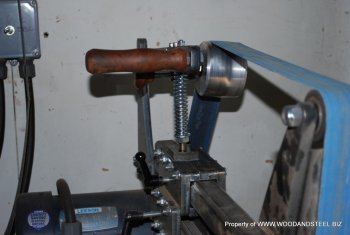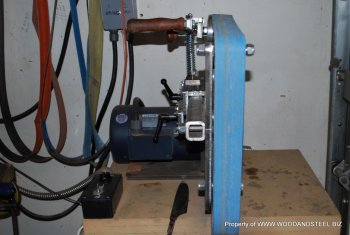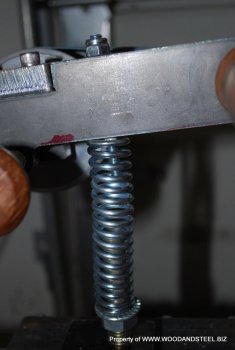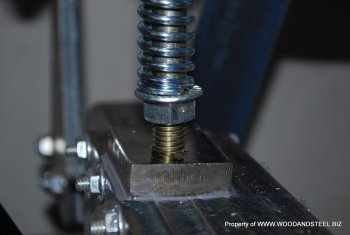At Paul's request, here is some more....I just finished building one for Jim Clow (Boatbuilder). The more I play around with these grinders, the more I like them. I might have mentioned some of these thing in my previous post, but I think they are worth repeating and keeping all in one place.
The first and foremost modification that I think is a MUST on these grinders is to dump the tension spring for belt tension...it just works poorly, no matter what you do. A compression spring is the only way to go IMO. It's done by mounting the idler arm, then locating where to drill/tap a 3/8"-16 threaded hole. Using a piece of all thread with a nut to tighten it down (make sure it doesn't protrude inside the receiver). The spring seat was made on my lathe from a piece of 1" round cold rolled. The hardest part is tapping that thing all the way through.

The spring came from the local Ace Hardware store. I suppose a person could build two of the spring seats, and mount one to the bottom of the idler arm, but I've not found the need....and it's just more parts to build.
Next, do not use the mounting hole for the idler arm. Drill another 1/2" hole as close to the end of the idler arm as is practical. This allows the idler wheel to be moved further forward, making for more precise tracking, and also lengthens the "throw" for more leverage when changing belts.
Idler wheel mounting....Most are using a simple 1/2" nut for the spacer between the idler wheel and the mounting block. I surface ground the nut down to 5/16" thickness, and that will bring the wheels into alignment (very important for smooth running and tracking).
I also like setting up the tracking adjustment like this:
Mounting the drive wheel.......when putting the drive wheel on the motor shaft, put it on just far enough to get a good bite with the set screw. Because the motor is mounted on inside of the frame, this makes the shaft too short if you mount the drive wheel all the way on the shaft. (no pic of that one)
If your going to mount the auxiliary receiver for a work rest such as the MAPP arm. Mount those parts one bolt hole forward....otherwise you must have an extremely long tooling arm for it to work.
(that's my 10" wheel/tooling arm....I had to test Jim's grinder to make sure everything was working right......I'll be modifying my grinder by moving the aux receiver one bolt hole forward as time allows)
Finally, on the inside of the KBAC-27 controller....there is a jumper (J4). From the factory it is set to 1X (motor speed). If you have a 1725/1750rpm motor, I would recommend setting that jumper to the X2 position. I found that at 1X the grinder is too slow to efficiently grind with heavy grits.
That's it for now....but I'm sure if I put more of these grinders together, I'll be tweaking as I go.

















